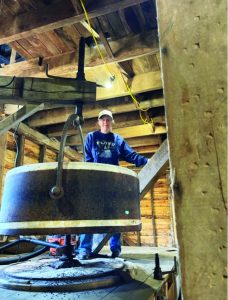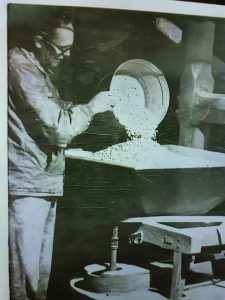
While sitting in her car outside the front of Roberson Mill with the warm sun pouring through the windows, Regina Roberson Cox muses about the many childhood days she spent inside. Visions of those younger, carefree times produce a keen sense of belonging to the historic building.
She remembers a time when the cogwheels were turning, one dependent on the other, to rotate the big millstones. The sounds were deafening as the old wheel outside pushed water over its top. It was loud enough to force anyone inside or outside to raise their voices to be heard in conversation.
 The water wheel was the driving force behind the grinding of wheat, buckwheat, and corn. When the job was done, the resulting flour varieties served as staple items that fed families in the local community as well as the surrounding areas. In fact, it was quite common for people to travel from other states for the sole purpose of purchasing a bag or two of Roberson’s buckwheat flour to make buckwheat cakes: similar in recipe to the more common pancake.
The water wheel was the driving force behind the grinding of wheat, buckwheat, and corn. When the job was done, the resulting flour varieties served as staple items that fed families in the local community as well as the surrounding areas. In fact, it was quite common for people to travel from other states for the sole purpose of purchasing a bag or two of Roberson’s buckwheat flour to make buckwheat cakes: similar in recipe to the more common pancake.
(Regina Cox standing at crane lifting one of the mill stones.)
Roberson Mill was built in the 1880’s by John Epperly; the man also responsible for the building of Epperly Mill in Floyd. In those days, Epperly was well known for his masterful craftsmanship. Roberson Mill and many others in Floyd were built in a time when engineering schools were unheard of, yet the evidence still exists today to prove just how talented the builders of these mills were. Epperly and others used old methods of construction that were passed down from generation to generation. Methods that were meant to last. Infact, John Epperly must have taken great pride in his workmanship way back then, as evidenced in the stamping of his name onto a steel arm inside the mill that supports the stone hoist.
 Homer Roberson, also known as Papa Roberson, purchased the mill in 1931, the same year his son, Harry Roberson, was born. Papa was well known for his hard work and commitment to the mill. It was his livelihood. At the end of each day, Papa was required to scotch or stop the water wheel from turning. This was to prevent the cogs from turning during the night when the machinery inside was not in use. If it had been allowed to continue turning, the all-important millstones would have been ruined from the lack of grain between the stationary bottom stone and the rotating top stone. (Harry Roberson).
Homer Roberson, also known as Papa Roberson, purchased the mill in 1931, the same year his son, Harry Roberson, was born. Papa was well known for his hard work and commitment to the mill. It was his livelihood. At the end of each day, Papa was required to scotch or stop the water wheel from turning. This was to prevent the cogs from turning during the night when the machinery inside was not in use. If it had been allowed to continue turning, the all-important millstones would have been ruined from the lack of grain between the stationary bottom stone and the rotating top stone. (Harry Roberson).
This was just one of the many responsibilities of the miller.
Although milling took place from mid-October to mid-December, the operation took much more planning throughout the year. There was a great deal of communication with suppliers and customers, all done without the benefit of modern technology. There was also the endless maintenance of not only the mill, but also of all the machinery and equipment used for delivering the products to homes and local stores.
 In the book, “The Water-Powered Mills of Floyd County, Virginia”, written by Ricky Cox and Franklin Webb, Cox talks about how Roberson Mill continued using waterpower even after other mills upgraded their technology.
In the book, “The Water-Powered Mills of Floyd County, Virginia”, written by Ricky Cox and Franklin Webb, Cox talks about how Roberson Mill continued using waterpower even after other mills upgraded their technology.
(Harry Roberson pouring corn in hopper to be ground. Circa 1970)
“Harry Roberson operated the mill under waterpower until the wooden race or flume collapsed about 1970. Electric power was used to grind buckwheat flour on a part-time basis until 1984. Phillip Gettel noted in a 1985 survey of Floyd area mills that a single poplar tree provided the weatherboard siding for one side, and both ends of the 2 1/2 story Roberson mill.”
Homer Roberson operated the mill until his death in 1966. It was Homer’s son, Harry, who then picked up the reigns and continued the family business as Roberson’s next miller.
Though Harry currently suffers from advanced dementia, on his more lucid days, his ability to describe the components of the mill’s machinery and the tasks performed by each is truly amazing. If his memory were still intact, he would likely be super excited about the efforts underway to restore this historic structure. He would be beside himself with joy.
And he wouldn’t be the only one. Regina Roberson Cox, daughter of Harry Roberson, tells us how important the mill was for her brother, Timmy. “As far back as memory allows,” she says, “Timmy was continuously researching avenues for ‘fixing’ the mill. As he observed the mill building’s deterioration and collapsing flume, he went to work drawing up diagrams and sketches – to the best of his abilities – depicting alternative methods which might cause the mill to ‘run’ again.”
Unfortunately, Timmy Roberson lost his battle with colon cancer in December of 2019. He didn’t have the chance to make his dream come true, and he left too soon to receive the good news about the restoration.
In the early part of 2020, Regina purchased the mill with a commitment to preserve it for future utilization as an educational site. She is excited about future generations exploring the mill’s heritage, as well as learning about the entire process of farm to table nourishment. In the fall of 2020, work was completed to secure the mill’s foundation and replace the exterior siding. The following summer, the exterior was painted to display a rustic, weathered look.
Though the exterior of the mill looks great, there remains much planning and work to be done for the interior. Top priority, however, will be replacing the roof, as there is evidence of rain damage on the third floor. A proposal for a new roof is currently in the works and upcoming fund raising will go toward this repair.
Thanks to the wonderful Floyd community and volunteers, prayers have been answered and plans to continue the restoration are underway. A committee has also been formed to facilitate the planning for future phases of the restoration.
The following fundraising events are planned for this spring:
• A poker run sponsored by Floyd Moose Lodge.
• An upcoming event at Floyd Country Store.
• A bluegrass/gospel music event – along with a silent auction and more – set for 2:00 PM on May 14th at Wildwood General Store, featuring The Comptons.
In addition, Regina and the committee are super excited to announce a cookbook in the works, featuring long time neighbors of Roberson Mill, as well as Harry Roberson’s cousins. One of the highlights will be Velma Roberson Reed’s famous German Chocolate cake recipe. Velma is Harry’s sole surviving sibling.
For updates on these events, and for those wishing to donate or to learn more, please visit online at Robersonmill.com. As time goes on, other phases of the restoration work will also be detailed on the website. The Roberson Mill restoration project can also be found on Facebook by searching Roberson Mill.
Roberson Mill • Regina Cox • www.RobersonMill.com
